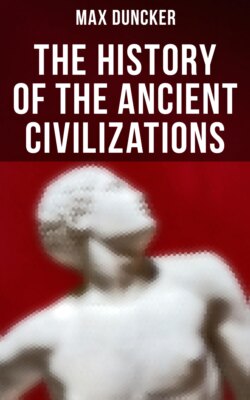Читать книгу The History of the Ancient Civilizations - Duncker Max - Страница 28
На сайте Литреса книга снята с продажи.
FOOTNOTES:
Оглавление[401] H. Rawlinson, "Journ. Asiat. Soc." 1861, 18, 2 ff.
[402] The assumption that the Birs Nimrud is the temple Beth-Sida at Borsippa is contradicted by the inscriptions. The measurements of the temple give no support for such a theory, even if the forty-two cubits of the cylinders of Rawlinson are interpreted with Norris, "Dict." p. 280, by Amatgagar; for we do not know the value of this measure exactly. I cannot regard Borsippa as a part of Babylon in the teeth of the direct testimony of Strabo (p. 728), Justin (12, 13), and Ptolemy (5, 20). The inscriptions of the Assyrians, and, not least, those of Nebuchadnezzar himself, always mention Borsippa beside Babylon. If it be maintained that in spite of this Nebuchadnezzar might have included Borsippa in the walls of Babylon, the theory is contradicted by Berosus (Joseph, "c. Apion." 1, 20), according to whom Cyrus besieges and takes Babylon while Nabonetus is blocked up in Borsippa, and by Nebuchadnezzar himself, who, after speaking of the great walls of Babylon, adds:—"I also laid the foundations of the walls of Borsippa, the Tabi-subur-su" (Ménant, "Babylone," p. 205).
[403] Herod. 1, 181–183.
[404] Diod. 2, 9.
[405] Strabo, p. 738.
[406] "Antiq." 1, 4.
[407] G. Smith, "Records of the Past," 5, 69, 73.
[408] Aberdeen inscription in Ménant, "Annal." p. 248.
[409] Cylinder Phillips in Ménant, "Babylone," pp. 210, 211.
[410] Cylinder of the British Museum in Ménant, p. 212.
[411] Ménant, "Babylone," p. 216.
[412] Ménant, loc. cit. p. 202.
[413] "Transactions Bibl. Arch." 2, 148.
[414] "Cyr. Inst." 7, 5.
[415] Cylinder Grotefend, in Oppert, "Exped." 1, 232. Chief inscription in Ménant, p. 206.
[416] Diod. 2, 8.
[417] Cylinder Phillips, in Ménant, "Babylone," p. 210.
[418] Herod. 1, 193. 2, 11.
[419] Xen. "Anab." 1, 7; Ammian, 24, 3; Strabo, p. 748, puts the borders of Babylon at a canal, 18 schœnes, i.e. 135 miles above Seleucia, and Seleucia was somewhat higher than Babylon.
[420] W. K. Loftus, "Warka, its Ruins and Remains;" "Transactions of the Royal Society," 2, 6, 1–64.
[421] Joshua, vii. 21.
[422] Brandis, "Münzwesen." s. 93.
[423] Brandis, loc. cit. s. 105 ff.
[424] Herod. 1, 194.
[425] Movers, "Phœnizier," 2, 3, 103.
[426] Brandis, "Münzwesen," s. 21 ff.
[427] Brandis, "Münzwesen," s. 71, 107, 121.
